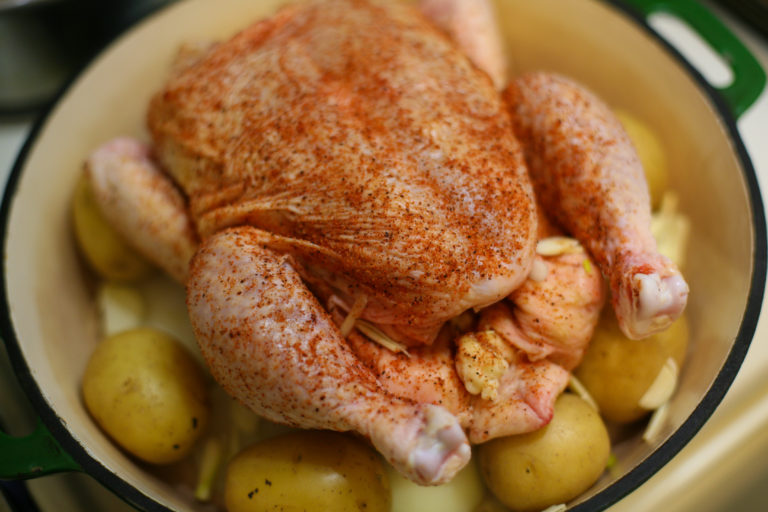
Chef's notes:
Roast beast is everywhere. It’s at weddings, funerals, Christmas, Easter, Thanksgiving, and pretty much every family gathering ever. It is one of the oldest forms of cooking; it dates back to the time when we built fires and figured out a way to capture that heat and conserve it. There are many different ways to roast a beast, but for chicken this the best way I have found.
The key with chicken or poultry in general is high initial temperature followed by a lid and medium temperature for the duration of the remaining cooking time. Also, you should know the terms “baking” and “roasting” refer to the same thing. The difference here is baking refers to cakes, breads, and pastries. If its anything else, it’s called roasting. One major exception to the rule is ham; you always hear baked ham but never roast ham. Weird, I know.
Ingredients
- 1 free-range NonGMO chicken
- Vegetable oil
- Sea salt
- Black pepper
- Fresh parsley
- Rubbed sage
- Dried rosemary
- Dried savory
- Fresh garlic, minced
- Dried thyme
- Crumbled bay leaves
- Dried marjoram
- 1 T pitted olives, chopped
- 1 T peppadew, chopped
- 1 T onion, chopped
Fresh Free-Range Non-GM Chicken Roasted with a Mixture of Herbs, Spices, and Aromatics
- Prep the bird and preheat the oven. Preheat the oven to 500 degrees F with the oven rack on the next to bottom position. Remove the bird from its packaging. Rinse it quickly under the faucet. If you are going to put it in the sink, make sure to scrub the sink with soap before and after the bird is placed inside. Next, dry the bird with paper towels. Rub with some canola oil. Add the desired seasonings. We used some classic poultry seasonings for this one—salt, pepper, parsley, sage, rosemary, garlic, thyme, savory, and marjoram. All the spices were dry, and we heated them a little in a pan to release some of the flavors and oils. Rub the chicken with the spices making sure to get all the nooks and crannies.
- To stuff or not to stuff. . . . I reserved a little of the spice mixture to mix with the aromatics going inside. I used some easy to find big flavors—pitted olives, peppadews, and marinated onions. I also added a couple of bay leaves to the mix. If you are going to use a denser stuffing (i.e., bread stuffing), you will want to cook the stuffing first so that you can be sure the inside of the bird gets done. Stuff the bird with the bread stuffing while it is still hot. This will give the inside a little head start as well. Or, if that sounds like too much work, you can just cook the stuffing separately. This will ensure that the inside of the bird gets done and no one gets sick.
- Place the bird in the preheated oven. Shut the door, set the timer for 30 minutes, and walk away. Do something else, but do not open the oven until the timer goes off. When you hear that timer chime its cheerful tune, pull the bird out and reduce the temperature to 350 degrees F. Cover the bird with aluminum foil and put it back in the oven. Now, depending on how big your bird is, you will roast to for 1–3 more hours. That is why you have a digital thermometer. Unless you are cooking game hens or pigeons, you can safely set the timer for 1+ hour. If you are roasting a large bird like a 15–18 pound monster, you can safely set the timer for 2+ hours. Regardless of the size or how sure you are it is done, use a thermometer. Place the probe into the deepest part of the breast. Read the temperature and test another spot. Use the lower temperature as a rule. You want the temperature to read 161 degrees F.
- When the bird has reached 161 degrees F, take it out of the oven. Let the bird rest for 15 minutes. This allows the meat to cool and the juices to settle down a bit. If you cut into the meat too early, all the juices will come running out and the result being the turkey from Christmas vacation. Fifteen minutes you say? The perfect amount of time to make some killer gravy with all those drippings. After the time has passed, carve the bird and eat. Don’t throw a scrap away—those bones make wonderful stock. If you’re not in the mood, just pack them in a bag and freeze them. I cover them with water in the bag, so they don’t get freezer burn. You’re gonna use water to make stock anyway.
Tips & Tricks
- One idea that eliminates all this checking and so on would be to get a thermometer with a detachable probe. You place the probe in the chicken, close the door on the metal cord, and place the readout on the outside of the oven. Simply set the temperature alarm to 161. This way, when the bird reaches 161 degrees F, the alarm will go off and you can just take the bird out.
- Instead of covering it with foil, you can leave the bird exposed. I would still cover the breast, though. White meat has a tendency to be dryer. Leaving the bird uncovered will get the outside a lot crispier, but it may also dry out the meat more, too. Have fun, and mix it up.
